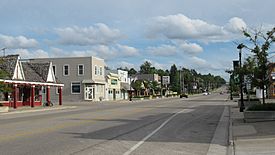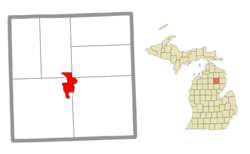Mio, Michigan facts for kids
Quick facts for kids
Mio, Michigan
|
|
|---|---|

Community looking south along M-33
|
|

Location within Oscoda County
|
|
| Country | United States |
| State | Michigan |
| County | Oscoda |
| Townships | Big Creek, Elmer, and Mentor |
| Founded | 1881 |
| Area | |
| • Total | 8.98 sq mi (23.26 km2) |
| • Land | 8.37 sq mi (21.67 km2) |
| • Water | 0.61 sq mi (1.59 km2) |
| Elevation | 1,020 ft (311 m) |
| Population
(2020)
|
|
| • Total | 1,690 |
| • Density | 201.91/sq mi (77.96/km2) |
| Time zone | UTC-5 (Eastern (EST)) |
| • Summer (DST) | UTC-4 (EDT) |
| ZIP code(s) |
48647
|
| Area code(s) | 989 |
| FIPS code | 26-54660 |
| GNIS feature ID | 1620853 |
Mio (/ˈmaɪoʊ/ MY-oh) is a small community in Oscoda County, Michigan. It is the main town of Oscoda County. In 2020, about 1,690 people lived there.
Mio is located where three townships meet: Mentor Township, Big Creek Township, and Elmer Township. Even though it's a busy place, Mio is not an official city or town on its own.
Contents
History of Mio
Mio was started in 1881. It was first called "Mioe" after Marla Deyarmond, whose husband Henry Deyarmond helped found the town. Other founders included Colige Comins, Reirlo Fosdick, and John Randall. The post office opened in 1882, and the name changed to Mio in 1883.
Michigan's Hottest Day
Mio holds the record for the highest temperature ever recorded in Michigan. On July 13, 1936, it reached a scorching 112 degrees Fahrenheit (44 degrees Celsius). Another town, Stanwood, had the same temperature on that day.
Farm Animal Incident in 1973
In 1973, something unusual happened that affected local farms. A worker accidentally sent a fire retardant chemical instead of animal feed. This mistake caused many farm animals, like cows, pigs, and chickens, to get sick. Over 35,000 cows were affected and had to be removed from the farms. About 1,300 of these cows were buried in a special pit in Mio. Even years later, small traces of the chemical could still be found in some people's blood in the area.
Important Historical Places
Mio has two special historical markers:
- Mio Hydroelectric Plant: This power plant was built in 1916 on the Au Sable River. It was the first plant to use a special design called a "conduit spillway," which helps manage extra water flow. This design was invented by William W. Tefft and made building power plants cheaper.
- Oscoda County Courthouse: The original courthouse was built in 1888. Sadly, it was destroyed by a fire in 2016. A new courthouse was started in 2019 and finished in 2020.
Amish Community in Mio
The first Amish families came to Mio in 1900 from Ohio. They were "Old Order Amish," meaning they followed very strict rules. The land was cheap, so more Amish families moved here, and the community grew fast. They used the land to grow crops like clover, hay, corn, and potatoes.
Over time, many of the Old Order Amish joined a different group called the Amish-Mennonite congregation, which had more modern beliefs. By 1954, the original Old Order Amish community in Mio ended.
However, in 1970, a new group of Amish, also from Ohio, settled in Mio. This community is now the fourth oldest Amish community in Michigan. Today, about 400 Amish people live in Mio. They still follow strict rules, but these rules can be a bit different from one Amish community to another.
Geography of Mio
Mio covers about 8.98 square miles (23.26 square kilometers). Most of this area is land, with a small part being water.
The Mio post office also serves many nearby areas. This includes parts of Mentor, Big Creek, Elmer, Clinton, and Comins Townships.
Natural Features Around Mio
Mio is located in Northern Michigan, right in the Au Sable River Valley. It is surrounded by the beautiful Huron National Forest and is close to the Rifle River State Recreation Area. The area is also part of the Au Sable State Forest. The Oscoda County Park is just a few minutes away, offering more outdoor fun.
Education in Mio
Mio-AuSable Schools teach students from Kindergarten all the way through 12th grade in one building. Middle school and high school students take seven classes each day, following a semester schedule.
The school offers some advanced classes, like AP Biology and AP Calculus. Students can also take college classes online through Kirtland Community College. If they earn a good grade, they get college credit that can be used at a university later.
The high school has about 170 students and 17 teachers. Some teachers teach both middle and high school students.
Population of Mio
| Historical population | |||
|---|---|---|---|
| Census | Pop. | %± | |
| 2000 | 2,016 | — | |
| 2010 | 1,826 | −9.4% | |
| 2020 | 1,690 | −7.4% | |
| U.S. Decennial Census | |||
In 2000, there were 2,016 people living in Mio. By 2020, the population was 1,690.
Most people living in Mio are White (about 97%). A small number are Native American or from other backgrounds. About 1.4% of the population is Hispanic or Latino.
In 2000, about 30% of households had children under 18. The average household had about 2.4 people. The median age was 38 years old.
Fun Things to Do in Mio
Mio is a great place for outdoor activities because it's in the Huron National Forest and near the Au Sable River. You might see animals like bears, deer, eagles, and turkeys!
Here are some fun things to do:
- Oscoda County Riverfest: A local festival celebrating the river.
- Amish Community: Visit local Amish stores and bakeries.
- Bird Watching: Look for different kinds of birds, especially the rare Kirtland's warbler.
- Boating and Paddling: Enjoy canoeing and kayaking on the river.
- Fishing: Mio is known for great trout fishing. There's even a Mio Pond Fishing Tournament for pike, walleye, and bass.
- Geocaching: A fun outdoor treasure hunt using GPS.
- Hiking: Explore the many trails in the area.
- Hunting: A popular activity in the surrounding forests.
- Kirtland's Warbler Festival: Celebrate this special bird that lives in the area.
- Mennonite Relief Expo & Fair: A community event with crafts and food.
- Michigan Shore to Shore Riding & Hiking Trail: A long trail for riding and hiking that goes through Mio. It's part of a 500-mile trail system.
- Nordic skiing: Enjoy cross-country skiing in the winter.
- The Michigan AuSable Valley Railroad: A miniature train ride through the Huron National Forest, about 6.3 miles away in Fairview, Michigan.
- Off-road Vehicle Trails: Ride ORVs, motorcycles, or snowmobiles on special trails.
- Steiner's Museum: See old pioneer artifacts in nearby Fairview, Michigan.
- Our Lady of the Woods Catholic Shrine: A peaceful religious site.
- Timberland Quilt Trail: See beautiful quilt patterns displayed on barns and buildings.
Local Events in Mio
Mio hosts many fun events throughout the year:
- First Dam Canoe Race: A canoe race on the river.
- Mennonite relief sale: A sale to help raise money for good causes.
- Michigan Magazine Craft Show: See and buy handmade crafts.
- Mio Mud Bogs & Drags: Exciting mud racing events.
- Nor-East'r Music & Art Festival: Enjoy music and art.
- Outdoor Sportsmen's Expo: Learn about outdoor sports and activities.
- Oscoda County Fair & Forestry Exposition: A traditional county fair with a focus on forestry.
Media in Mio
Here's how you can get news and entertainment in Mio:
Newspapers
- The Oscoda County Herald is a weekly newspaper. It covers news and sports from all over Oscoda County and nearby towns. It's the only newspaper in Oscoda County recognized by the Michigan Press Association.
Radio
You can listen to many FM radio stations in Mio:
| Call sign | Frequency | City of License |
|---|---|---|
| WJOJ | 89.7 | Harrisville |
| WPHN | 90.5 | Gaylord |
| WCML | 91.7 | Alpena |
| WFDX | 92.5 | Atlanta |
| WAVC | 93.9 | Mio |
| WKJZ | 94.9 | Hillman |
| WCMB-FM | 95.7 | Oscoda |
| WUPS | 98.5 | Harrison |
| WATZ | 99.3 | Alpena |
| WGRY | 100.3 | Grayling |
| WMJZ | 101.5 | Gaylord |
| WKJC | 104.7 | Tawas City |
| WHSB | 107.7 | Alpena |
There are no AM radio stations that clearly reach Mio during the day.
Images for kids
See also
 In Spanish: Mio (Míchigan) para niños
In Spanish: Mio (Míchigan) para niños





